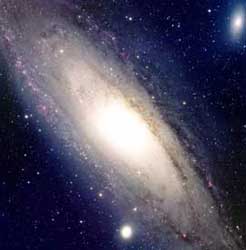Our Very Own Black Hole
About the Milky Way
The Milky Way is a vast spiral, similar to our neighbor the Andromeda galaxy, shown in the photo. From our perch in one of the spiral arms, we can see the Milky Way as a great band of stars across the sky (provided we are far from an urban area).
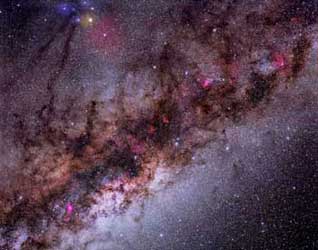
This photo clearly shows the dust lanes looking towards the center of the Milky Way galaxy. These dust lanes obscure the center of the galaxy in visible light. (photo credit: Dave Palmer)
Where is the center of the Milky Way? Astronomers answered this question by carefully mapping the distribution of stars, and by 1930 they placed the center in the constellation Sagittarius, near its border with Scorpio. Looking in this direction with an optical telescope—all that was then available—revealed nothing of the center, which is totally obscured in the visible spectrum by broad lanes of dust, as shown in the photo. The size of these dust particles is approximately the same as the wavelength of visible light; therefore, this light is strongly scattered. Telescopes using light with a larger wavelength were clearly needed, and they were not long in coming.
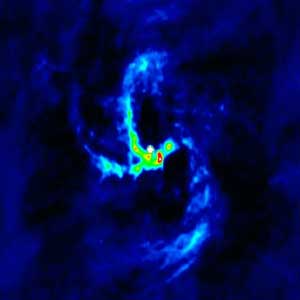
This radio image, made at a wavelength of 3.6 cm, shows the extremely compact radio source-- the bright spot--at the center of the Milky Way galaxy. The spiral pattern is made by ionized gas that is orbiting the object in the center. (image credit: NRAO/NSF)
Radio astronomy began in 1930 when electrical engineer Karl Jansky, investigating radio static, found a source of radio noise in Sagittarius. At much shorter wavelengths, infrared observing technology developed as well, and both the radio and infrared results showed a highly localized energy source at the same location.
Fast forwarding to 1971, Martin Rees and Donald Lynden-Bell, both of the University of Cambridge , hypothesized that a black hole at the center of the galaxy could explain the intense radio source observed there. The mechanism is the acceleration of charged particles spiraling into the black hole, since accelerated charges produce electromagnetic radiation. Then, in 1981, Mike Watson, of Leicester University , using the Einstein X-ray Observatory, found well-defined sources of x-rays very close to the galactic center. In fact, x-ray emission is predicted to occur very close to a black hole, due to heating of the accretion disk of matter in orbit about the black hole. However, the x-ray energy was much fainter than expected—a puzzle to this day.
In a quite different approach, infrared astronomers began in about 1980 to explore the dynamics of both gas and individual stars orbiting the presumed black hole. The idea was right out of introductory physics—the orbit and period of an object moving in a gravitational field determine the mass of the object whose gravity produces the orbit. (see sidebar)
v2/r = GMc/r2
We can solve for Mc:
Mc = v2r/G
So by measuring the velocities of objects in orbit, or equivalently their periods, we can find the mass of the central object.
We have used Newton 's theory of gravity to do this calculation. For objects close to a black hole, it may be necessary to include corrections due to Einstein's theory of general relativity, but the principle is the same—measuring the orbital parameters enables one to determine the central mass.
Research
Motion of both stars and gas about the center of the Milky Way galaxy has provided strong evidence of the existence of a black hole. We'll concentrate on the investigation of the orbits of stars. Underway since about 1980, this effort is now led by Andrea Ghez's group at UCLA, which uses the Keck telescope in Hawaii . Key to the group's success is adaptive optics (see sidebar), a technique that compensates effectively for distortions due to Earth's atmosphere.
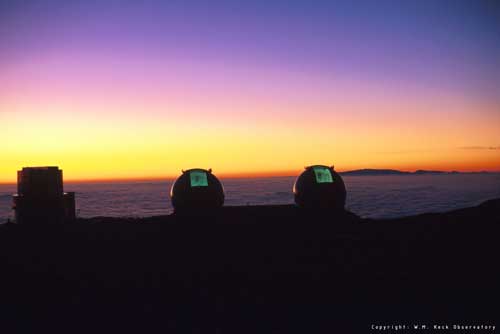
The twin Keck telescopes-- one images in the infrared and the other in visible light-atop Mauna Kea, Hawaii. (photo credit: W. M. Keck Observatory
The image, made with infrared light, shows the region within about a tenth of a light-year of the galactic center, with the observed positions of stars for the past nine years superimposed on the most recent image (for comparison, the diameter of the Milky Way is about 100,000 light years). A yellow five-pointed star marks the center of the galaxy, which coincides with the intense, compact radio source mentioned above. This point appears to be at rest—its motion against the background of extremely distant objects (quasars) is accounted for by the Sun's rotation around the center of the galaxy.
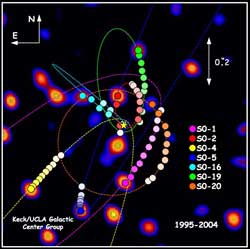
Infrared image of stellar orbits around the object at the center of the Milky Way. The image shows approximately the innermost three light years of our galaxy. Note the short periods of these stars, which indicate a central mass of 3.7 x 10 6 suns. (This image was created by Professor Andrea Ghez and her research team at UCLA and are from data sets obtained with the W. M. Keck Telescopes.)
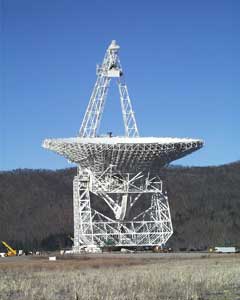
A radiotelescope at the National Radio Astronomy Observatory in Green Bank, West Virginia. (photo credit: NRAO/NSF)
The closest-in star, shown in various shades of red, has completed more than three-quarters of an orbit during the time of observation. At the distance of closest approach—slightly larger than the radius of Pluto's orbit—it is moving at 4% of the speed of light. To bend an object with such a huge velocity into this tight orbit requires an extraordinary central mass, which the Ghez group has determined to be 3.7 million suns.
As for the size of the black hole, results from recent radio astronomy indicate that this object is about the size of about one Earth-orbit, ruling out alternatives and establishing that it is a black hole. The data in this study came from combining the observations of ten different radio telescopes, at locations ranging from Hawaii , across the continental U.S. , and the U.S. Virgin Islands. This system, known as the Very Long Baseline Array (VLBA), provides the resolution—the ability to see fine detail—of one extremely large telescope.
Although the black hole at the center of the Milky Way is now well-established, a question remains about the stars in this region. The Ghez group has identified young stars nearby, but the strong tidal forces near a black hole make it seem an unlikely place for star formation, leading to the hypothesis that these young stars formed further out. On the other hand, x-ray astronomers, working with the satellite observatory Chandra, determined the size distribution of these young stars and ruled out the possibility that they were formed away from the center. This question is still unresolved.
Another question is how a compact object with a mass of 3.7 million suns would form. But it seems to have happened frequently, since astronomers have concluded that a supermassive black hole resides at the center of most if not all galaxies.
Links
UCLA Galactic Center Group
National Radio Astronomy Observatory
Chandra X-ray Observatory
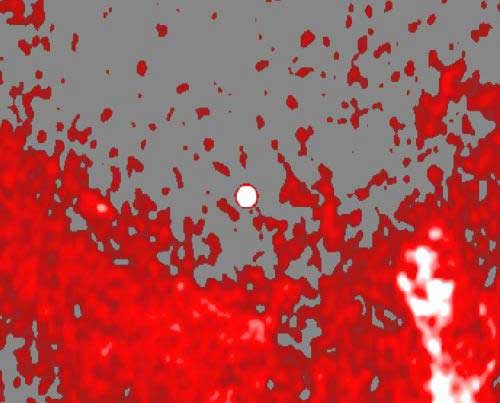
The intense radio source at the center of the galaxy. Its size is about the same as the orbit of Earth. (Image courtesy of NRAO/AUI)










